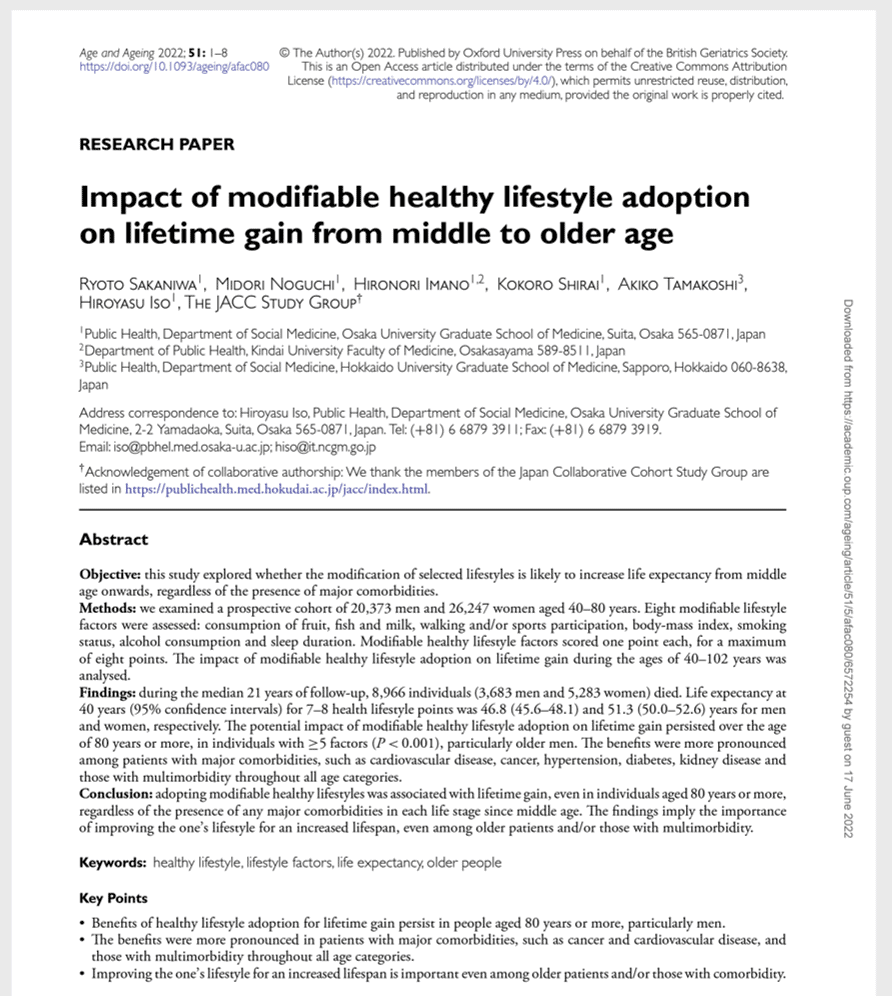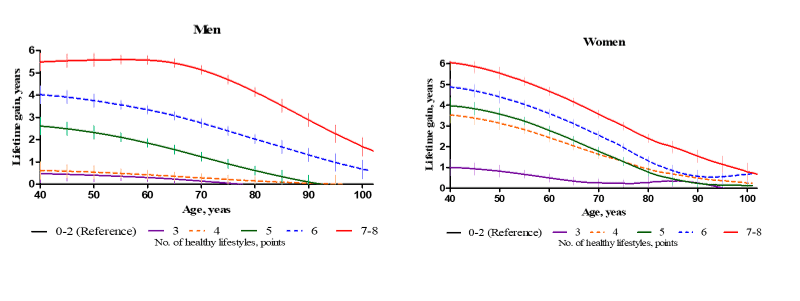Want to Live Longer? New Research Says Do These Simple Things…

Given the hundreds of billions spent every year on supplements and various “anti-aging” treatments we’re all fighting father time. In a way, that’s also what I do at Regenexx, focus on how to keep aging musculoskeletal systems going without big, life-altering surgeries. However, are there some really simple things you can do to cheat death? The research is getting increasingly clear that the answer is likely a resounding yes. Let’s dig in.
The Fight Against Gravity and Aging
It’s tough getting old. At Regenexx, our focus is helping aging weekend warriors stay active much longer than their parents ever could. Do you remember your aging parents being able to hike 20 miles, ski black diamonds, or lift weights at 50, 60, 0r 70? For most of us, the answer is a resounding no. That stuff just didn’t happen back then. Now with interventional orthobiologics, we routinely keep aging people able to do what they love at these ages. We do that by proactively treating small problems. For example, last month our Colorado medical practice was rushed by dozens of people who had big plans for this summer’s travel season. From hiking with llamas to walking all around Europe, the theme was all the same. “Can you treat ______? I have a big trip coming up that I don’t want to miss”.
Living Longer?
Can you live longer? There’s a whole medical industry devoted to this concept. However, what does the research show works? Can I do some simple things that will buy more years?
There have been hundreds of studies on this topic, but this morning let’s dive into a recent one that seems to be heading in the same direction as many others. This research was performed in Japan.

Credit: 2022 R.Sakaniwa et al. Impact of modifiable healthy lifestyle adoption on lifetime gain from middle to older age. Age and Ageing
In this study, 45,021 people were studied from 1988 to 1990 and the subjects continued to be monitored until 2009 (1). Each healthy lifestyle factor like diet, exercise, smoking, sleep, and BMI was given a point. The graphs above begin to tell the story of the results. Each line represents an increasing number of lifestyle points. The x-axis (bottom) is the age at which the subjects adopted the healthy lifestyle and the y-axis is the gain in years of lifespan. For example, let’s take the red line, which is adopting 7-8 healthy lifestyle points. Men (graph on the left), saw almost 6 years more life (red line), and that effect was seen even if they adopted those at age 60. That red line then begins to drop off a bit by 70, but those that adopted a healthy lifestyle at age 70 still saw 5+ more years. The graph on the right shows that for women, starting these earlier is better, as all lines decline as the age of start gets older. That also may be because women generally live longer than men.

Credit: 2022 R.Sakaniwa et al. Impact of modifiable healthy lifestyle adoption on lifetime gain from middle to older age. Age and Ageing
Interestingly, the more comorbidities, the bigger the effect. Meaning sicker people with more medical issues like diabetes, high blood pressure, or cancer had more life gains by adopting these habits. In the graph above, people on the left with no chronic illnesses who adopted 6 or more of these lifestyle choices added about 3 years if they began at age 50 or 65. However, people with one chronic illness (say prediabetes or type 2 diabetes) added 6 years if they adopted those lifestyles by age 50. People with two or three chronic illnesses gained 8 years if they began by age 50 and 7 years if they began by age 65!
What are the Lifestyle Changes that Moved the Needle the Most?
Reducing alcohol intake, not smoking, losing weight, and increasing sleep had the biggest lifespan gains. So here’s a plan to add years to your life:
- Pick one day on the weekend to drink moderately. That means stopping the 1-2 glasses of wine or beer a night and moving that to the weekends only.
- Don’t smoke. I think that this is an easy one as most people don’t smoke these days. Also, realize that this effect may be the same for smoking or vaping marijuana (the jury is still out on that one) (2,3). Hence, if you like THC, use edibles.
- Lose weight by adopting the Dr. Centeno diet plan. This isn’t something you can buy, but more a lifestyle choice I made on coming out of the pandemic, where I had gained a good 20 pounds (just look at my pandemic FB lives to see my increasing chubby face!). Since then I committed to losing that weight because I was getting concerned that as I was racing toward 60, I was also playing with fire with regard to my health. How did I do that? I stopped drinking wine every night, stopped using dark chocolate as my daily caffeine source, and began drinking a shake every morning for breakfast and dinner while eating a healthy salad with chicken for lunch. There are obviously many different ways to get there, but I’ll post my shake recipe below.
- Sleep. Become religious about your sleep. That means going to bed early almost every night and making sure that you spend 8-9 hours a day in bed. For some this may mean working on things like mechanical sleep apnea.
The upshot? What’s amazing about this study is that you can add so many years of life even if you have chronic medical conditions by changing some things later in life. So please review what you’re doing now, so you can begin as early as possible! While we can keep you hiking, biking, and skiing, wouldn’t also be wonderful if you could tweak a few things that will make sure you’re around longer for your kids and grandkids!
__________________________________________________________________
Dr. C’s Shake Recipe:
-2-4 cups of high protein flax milk (depending on your size and caloric requirements)
-One fistful of unroasted and unsalted whole cashews
-One scoop of protein powder of your choice
-1/2 to a whole small avocado (depending on your size and caloric requirements)
-1-2 cups frozen berries (depending on your size and caloric requirements)
-1-2 tablespoons of matcha (morning shake only)
-1 teaspoon to 1 tablespoon of cinnamon
Blend until smooth. Makes 1 1/2 to 3 tall glasses of shake (depending on your size and caloric requirements). This serves as your breakfast and dinner, meaning no snacks.
References:
(1) Ryoto Sakaniwa, Midori Noguchi, Hironori Imano, Kokoro Shirai, Akiko Tamakoshi, Hiroyasu Iso, The JACC Study Group, Impact of modifiable healthy lifestyle adoption on lifetime gain from middle to older age, Age and Ageing, Volume 51, Issue 5, May 2022, afac080, https://doi.org/10.1093/ageing/afac080
(2) Oncolink. Marijuana Smoking and Cancer Risk. https://www.oncolink.org/risk-and-prevention/smoking-tobacco-and-cancer/marijuana-smoking-and-cancer-risk
(3) Chadi N, Minato C, Stanwick R. Cannabis vaping: Understanding the health risks of a rapidly emerging trend. Paediatr Child Health. 2020;25(Suppl 1):S16-S20. doi:10.1093/pch/pxaa016

NOTE: This blog post provides general information to help the reader better understand regenerative medicine, musculoskeletal health, and related subjects. All content provided in this blog, website, or any linked materials, including text, graphics, images, patient profiles, outcomes, and information, are not intended and should not be considered or used as a substitute for medical advice, diagnosis, or treatment. Please always consult with a professional and certified healthcare provider to discuss if a treatment is right for you.
